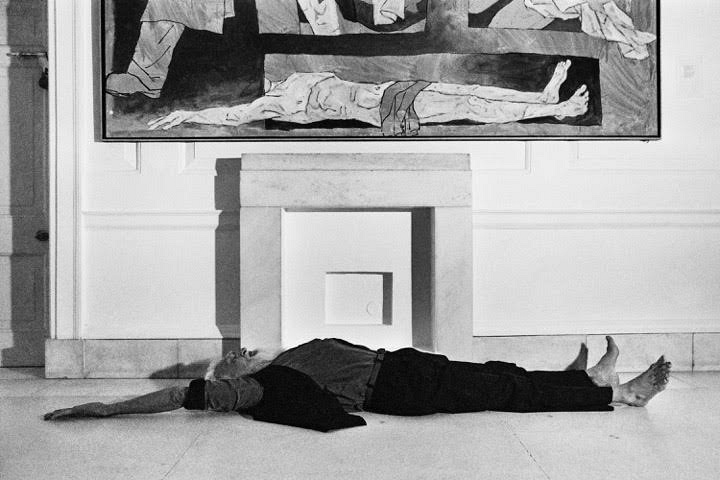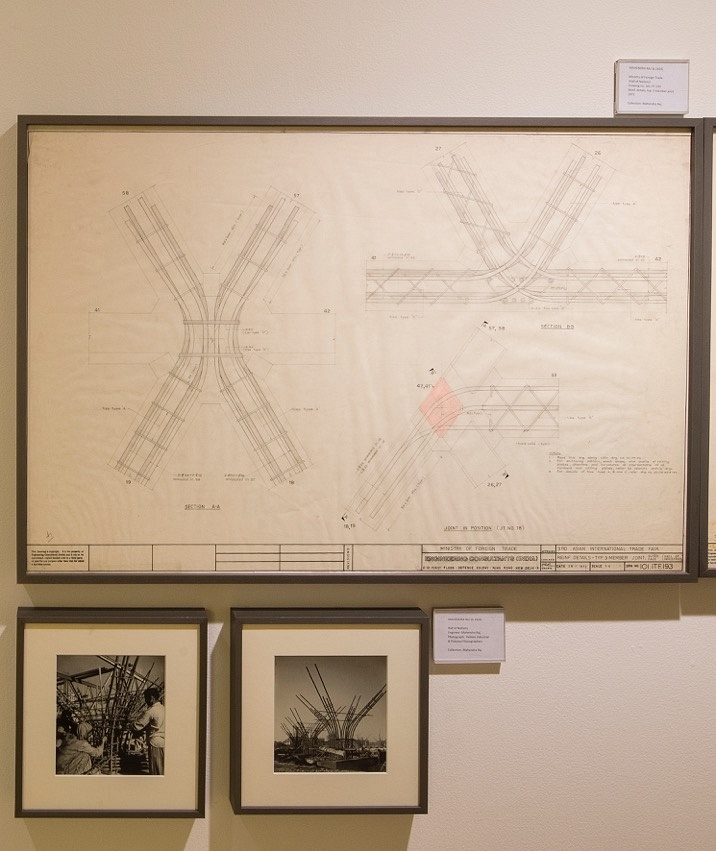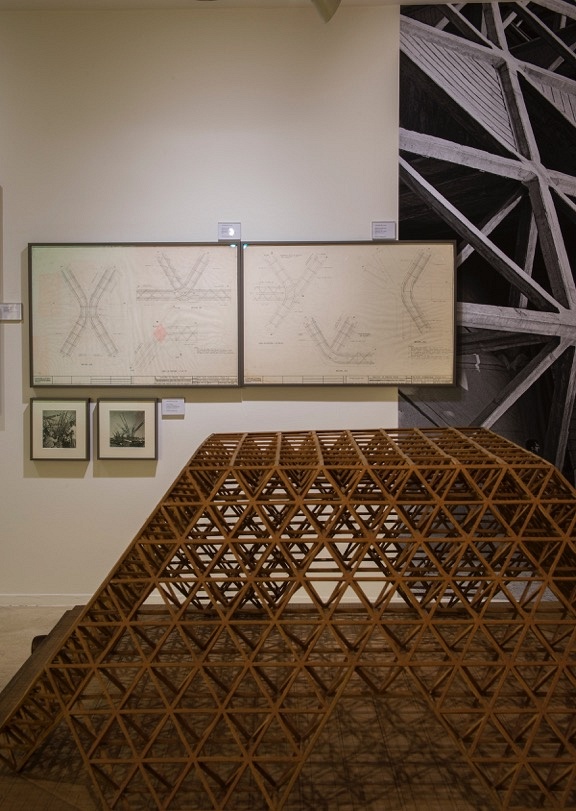I have never really liked the work of India’s most famous painter, Maqbool Fida Husain. If he created some interesting work in the early days of his career in the 1950s, then, from the end of the 1960s, it starts to repeat the formula of a mannered sub-Picasso married to the very self-conscious ‘Indian’ vernacular that Husain developed and marketed so successfully.
I recently found myself looking at some early and midcareer canvases by Husain at the Kiran Nadar Museum of Art (KNMA) in Delhi and realized how irrelevant my aesthetic dislike for his work is. One of the towering figures of the post-Independence cultural scene in India, Husain died in Qatar in 2011 at the age of ninety-seven. The reason he was in Qatar and not one of his homes in Bombay or Delhi was that the Hindu right-wingers had hit the old man with over a hundred court cases for “intent to hurt religious sentiments.” The cases were lodged in courts all over the country, many in small and obscure towns, accepted by provincial magistrates and judges who felt no hesitation in admitting the charges. Legally this means that a man in his nineties would be obliged to travel to many if not all of these places to present himself in court. Along with the court cases came a flood of death threats. All of this had been preceded by a campaign begun in the early 1990s by Hindu fascist mobs that attacked Husain’s house and vandalized galleries and museums that exhibited his paintings. The apparent triggers for this hatred were a few drawings Husain had made in 1970, depicting Hindu goddesses in mildly erotic images. Added to the ‘crime’ was a painting he had made of ‘Mother India’, showing her naked, with the different states of the country demarcated across her body like a map. None of these works created a stir when they were first shown, but in a post-Khomeini, copycat ‘Hindu fatwa’ mode, the rising Hindu fascists dug out reproductions of these drawings and paintings to target a major Indian cultural figure who happened to be Muslim.
Displayed as part of the KNMA’s show “Stretched Terrains” (3 February to 31 July 2017), alongside Husain’s paintings and those of FN Souza and SH Raza, two of his contemporaries in the Bombay Progressives group, were a series of photographs of Husain by Parthiv Shah, taken between 1993 and 2003 when Husain and Shah walked around locations in Delhi including the Sufi shrine of Nizamuddin, in the south of the city. Throughout his life, Husain was a quiet but very conscious performer. A tall, handsome man, he cultivated his ‘profile’ as a sharp nosed, sumptuously bearded man with a high forehead—in the later years the beard and mane turning an instantly recognizable clean silver. In these photographs, Husain walks around his city, poses against architecture, lies supine in an alcove like a Buddha figure, and so on. The photographs are a record of a young photographer’s informal interaction with a famous man who both does and does not take himself seriously, who is willing to, if not laugh, smile broadly at himself and at his self-authored iconicity. But on another level, in the heavily Hindutva-ridden Delhi of 2017, the large presence of the man in a major gallery takes on quite a different significance: whatever the Hindu fascists’ efforts, it is a strong political statement to show a series of portraits of a man who was forced into exile by them. Whatever the state institutions might be doing, the fact that private art spaces can still produce the odd gesture of protest is somewhat heartening.
In another of the exhibitions at the KNMA, photographer and cultural activist Ram Rahman put together a loving and precise presentation of documentation of the work of five architects who were central to the building of modern institutional New Delhi after the departure of the British in 1947. As Jawaharlal Nehru, India’s first prime minister, invited Le Corbusier to execute his dream capital in nearby Chandigarh, he also encouraged these men, some of whom had returned to India after studying under other great architects abroad, to imagine and realize a series of contemporary buildings in which the new institutions of a fledgling republic would be housed. The idea was to project a modernity divested of excessive decoration, yet one that reflected the great and varied architectural history of India. The buildings and planned urban areas that came up in the next two decades displayed both a raw-concrete unity as well as quite eclectic modernist influences. Walking through the small exhibition it was fascinating to see plans and models, and the photographs of now familiar buildings being constructed or at the spanking new moment of their completion. Often the structures stood in middle of otherwise barren plots of land, like objects delivered by alien spaceships, the sharp black-and-white images bringing out the planes and curves arching into a startlingly clear, pre-pollution-era sky. Nehru died in 1964 and this impetus, this marriage of modernist aesthetic to governmental will, died out too by the late 1970s. With its rapid expansion and mutating demographics, Delhi transformed from a dry, institutional backwater into a brash, brittle, and crowded late-twentieth-century city. Many of these buildings are now surrounded by layers of development, the clear planning vision buried under the needs of the very wealthy or the very poor.
Among the last of these building projects was Pragati Maidan—“Progress Park”—in central Delhi, where in 1972 architect Raj Rewal and others built exhibition pavilions meant for the many different expositions that would be coming to Delhi. In these, one of the wonders is Rewal’s Hall of Nations, a set of structures that employ a modern variation of the traditional Indian jaali [net], a concept to block the sunlight while allowing air to circulate. This group of buildings was built entirely by hand by skilled labor in a feat that showed off the technology and design imagination of a twenty-five-year-old nation. With the coming to power of Narendra Modi and his Hindutva government in Delhi, the mob that carried out the concerted attack on Husain now had a prime minister and cabinet to provide an umbrella as well as legislative sanction for their goon actions. Even as the attacks increased on anyone who was seen to be against the extreme Hindu right-wing agenda, the government itself began the work of dismantling and erasing the secular—and this naturally included the modernist legacy of Nehru. Pragati Maidan and its buildings are now being demolished to make way for a new exhibition center. The Hall of Nations is on the hit list of buildings to be taken down and a group of activists has lodged a case in the High Court to stop the demolition. The argument is that the Hall of Nations and other buildings also form part of India’s heritage, albeit of a more recent vintage. At the time of this writing, the verdict on the demolition is yet to be delivered. Should the High Court not come through with saving the buildings the petitioners are ready to take the matter up to the Supreme Court.
When Modi came to power in May 2014 we were promised by his right-wing apologists in the media that things would be more or less ‘normal’, business as usual, except without corruption; that the ‘ease of doing business’ would improve; we would have a right-of-center government, stronger on national defense and tougher with Pakistan; but there would no great draconian clampdown—that all this was just the fear-mongering of the elite leftist intelligentsia that had been disempowered by Modi’s victory. In less than three years these assurances have proved to be disastrously hollow. One by one the heads of important cultural institutions have been replaced by people with clear right-wing allegiances. There has been a concerted institutional attack on public universities, where the non-elite can still receive higher education. There are regular attacks on any university seen as leftist or radical, labeling them as “anti-national,” harboring “traitors,” and encouraging “sedition.” These attacks are synchronized with physical violence, which has been backed by the police making false cases, even as they refuse to accept cases against the Hindu fascist street thugs. And all of this is backed by a large section of the media, which, according to Ravish Kumar—one of India’s few liberal television anchors—now sings the ruling party’s bulletins instead of just reading them aloud.
If last year the attack was on Delhi’s Jawaharlal Nehru University (JNU), seen as a “red serpents’ nest” by the ruling party and their students’ body the Akhil Bharatiya Vidyarthi Parishad (ABVP), the campaign later spread to other centers of higher education. In February 2016, a demonstration at JNU by various Left factions was targeted by the ABVP and certain pro-Hindutva television news channels, who accused all present at the demonstration of being pro-Pakistan, in favor of the state of Kashmir breaking away from India, and therefore traitorous and seditious, going as far as labeling one of the students a terrorist. As evidence, the channels showed videos that were later proved to have been doctored by the channels. Based on this and little else, the police arrested many student leaders. When the president of the JNU students’ union, Kanhaiya Kumar, was brought to court, lawyers clearly aligned to the Hindutva agenda beat him up the as the police escort watched. No great punishment was handed to the lawyers who participated in this outrageous act of violence; neither did the guilty television channels have to pay too much of a price. Later, all the student leaders were released, but on bail, with the cases against them still pending.
Barely a year later, this February, Ramjas College, a part of Delhi University, announced a seminar around cultures of protest and invited Umar Khalid, one of the targeted student leaders from JNU, to speak. Khalid has a case pending against him for sedition, in which he is alleged to have encouraged the secession of Kashmir. Khalid denies these charges and the paper he was supposed to present had nothing to do with Kashmir—it was based on his PhD research on the troubled state of Chhattisgarh in the center of India. For the ABVP, any kind of participation by the ‘traitor’ Khalid in an event outside the ‘red bastion’ was unacceptable and they demanded that Khalid be disinvited—a demand that was met by the authorities at Ramjas. The ABVP cadres then surrounded the seminar venue and began to pelt it with stones. Others from the union walked into classes and demanded they be allowed to monitor what so-called seditious messages the professors were imparting to their students. Knowing there would be trouble from the ABVP, the leftist student unions from JNU had also gathered outside Ramjas. As violence erupted on the campus, students and teachers attending the seminar tried to escape. Outside they were met with violence from the ABVP, with a teacher and a few students seriously assaulted. Despite their heavy presence, the police stood by and watched as the action unfolded. Later, there were allegations and counter allegations from both student groups, but the ABVP could not produce a single phone video or news channel clip to back their claim that it was in fact they who had had been assaulted by the leftist demonstrators.
The Ramjas incident and its aftermath unfolded right in the middle of Delhi’s “art season.” From October till the hot season hits in April, Delhi is the one place in India where you can find the widest variety of art, everything from shows of pretty pictures to the most arcane conceptual profferings. The KNMA shows mentioned were among the most interesting of all the work on offer at the time of the India Art Fair in February. In the galleries spread across south Delhi were solo shows—Atul Dodiya’s virtuoso quotations about historical representations of women, Seher Shah’s architectural abstractions, Ranjani Shettar’s sculptural installations. In Lodhi Colony, built in the 1930s to house the British Empire’s lower-level administrative staff, there was an attempt at public art where a group of Indian and international artists simply enlarged their images to wall-size and house-size scale, work that bore little connection to the local urban context or the times in which we live.
In between all these exhibitions—some brilliant, some good, a lot very mediocre—the question arises of the role (or roles) art could play in these tricky times in India. As the official eraser continues to rub across the surface of the country, violently wiping out collective memory and distorting history, it is clearly time to move beyond the merely formal values of art making (without, however, forgetting or neglecting the sensual and the experiential), to rediscover or imagine work that pushes against the grain, that retrieves, that forces subtle and not-so-subtle remembrance, that protests on multiple levels from the direct to the arcane, that retains history and imagines a different future. It has always been too tall an order for art by itself to keep alive the fight against injustice and oppression, but it is in chinks, in the cracks in the walls, where art could prize open the possibilities of resistance.
On April 7, artist Zuleikha Chaudhari staged a hearing at the Constitution Club of India titled Landscape as Evidence: Artist as Witness. The performance brought together artists working on ecological issues, a retired chief justice, and two leading lawyers of the Indian judiciary to examine whether artists could serve as witnesses and their artwork admitted as evidence against disastrous decisions made by the state. The three-hour ‘hearing’ was at once audacious and ambitious and it brought to the fore the urgent need for the artist’s role as a citizen, the need for art to emerge from white cubes into activism, and for art to think and perform strategically in these politically challenging times. Whether it is artists like Chaudhari or the photographers, architects, heritage conservationists, and urbanists who are the petitioners trying to protect the Hall of Nations, art practitioners are being forced to find new ways to engage, and that perhaps is the one silver lining in these absurdly dark times.
Postscript: On the night of April 23, the Hall of Nations and the three Hall of Industries buildings in Delhi’s Pragati Maidan were demolished in a fait accompli, even as the petitioners trying to stop the demolitions waited for the court’s decision on the matter. It was a sad day for Delhi’s modernist architectural heritage, and made Modi’s call to “Make in India” ring ever more hollow as this great example of intermediary technology made entirely by Indian hands was razed to the ground.


